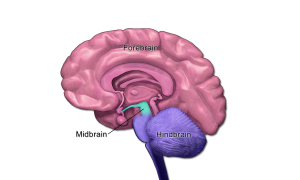1 1.3 Organization of the Brain
Section Learning Objectives
1.5 Identify the major structures of the brain.
1.6 Describe the behavioral functions associated with the major brain structures.
The brain is command central for all we do and think. It takes in sensory information from the environment and internal organs. It interprets the information and integrates it with previously stored information. It then commands the muscles and body to take action in a response. For example, if there are leftovers in the refrigerator that are past their expiration date, the brain registers the olfactory information coming in through the receptors in the nose. This information is integrated with information stored from past experiences with spoiled food. The brain then formulates the motor plans to remove the expired food and take it to the garbage can.
There are three major subdivisions of the brain: the hindbrain, the midbrain, and the forebrain. These sections are identified in Figure 1.2. The more reflexive or automatic a behavior is, the more likely it is to be controlled by the hindbrain and midbrain. Complex behaviors, like taking out the garbage or learning algebra, require activation of the brain structures in the forebrain. Brains vary greatly in size and shape across species. The greatest variations occur in the forebrain which are much more complex in mammals than reptiles or fish. Animals such as humans, chimpanzees, and dolphins have the most complex brains.

